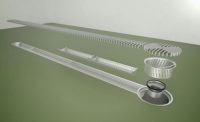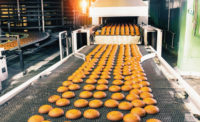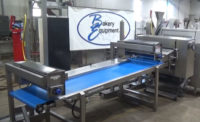Several aspects of snack and bakery production facilities require regular maintenance in order to preserve the safety of works—and the final product.
Cornerstones of safety
“When performing regular maintenance on the structure of a snack/bakery production facility, we look to the floors,” says Jimmy Hunt, North America business development manager, BLÜCHER, a Watts brand, North Andover, MA.
While much attention is placed on food contact surfaces, floor drains are the most frequent site of positive screenings for pathogens, and are often a root source of contamination, notes Hunt. “Most drains are inherently unsanitary and difficult to clean, which is why selecting the right drainage products for the application can be crucial.”
There are several red flags to look for in floors and coatings when performing regular maintenance. Many of these are easy to spot, because they’re visually apparent, such as cracking, spalling, delamination of coatings, chipped or worn edges and transitions, or material removed from mechanical impact, says Nick Nelson, product manager, Indue, Hudson, WI. A failure to address these issues quickly can lead to further degradation of the coating. Other maintenance points to look for include:
- Drainage problems and pooling resulting from improper slope and pitch or faulty design
- Surface profiles that are too smooth and/or slippery, presenting a safety hazard, or too aggressive or pitted, which can reduce surface cleanability
- Excessive wear or degradation from chemical exposure caused by drips, leaks or regular exposure to harsh cleaners, sanitizers or corrosive manufacturing byproducts
- Hollow spots where the coating or substrate is structurally unsound
- Joints that are cracked, failing or no longer adhere to both sides of the joint
Such areas can become safety hazards for personnel or harborage points for bacteria and microbes, notes Nelson. He notes that brick and tile floors need to be examined for worn grout lines; loose, cracked and/or broken bricks or tile; hollow spots; and failing mortar beds. “Once the tile bed is exposed, moisture and corrosive materials can spread horizontally under the surface and into the unprotected substrate,” he says. This can lead to costly issues ranging from mold growth and other microbial contamination to structural failure of the slab, which may necessitate its removal.
“With any flooring system installed in a bakery, regular inspection and maintenance will extend the overall life of the floor,” says David Senn, global account manager, Stonhard, Mapleshade, NJ. He advises checking for:
- Slip-resistant texture levels that can wear down over time, especially in high traffic areas, and could become a potential slip hazard
- Cracks or hardening in expansion joints and floor-to-drain transition points that might need repair to ensure they remain sanitary
Where possible, the use of round drains is recommended to alleviate the stress point that causes these hairline cracks.
“Areas that we see the most problems are the ones that see high chemical exposure due to cleaning, washing or manufacturing processes, such as CIP and chemical storage rooms, HTST areas, wash bays and rooms, and production areas,” says Nelson. “High traffic and heavy traffic areas can also prove to have elevated maintenance needs due to the high amount of mechanical wear.”
Stephen Ward, manager, quality assurance, EMEA GMPs, AIB International, Manhattan KS, recommends that as part of a multidisciplinary self-inspection program, the following areas are important to review when deciding on maintenance priorities:
- Holes and gaps in the walls, especially when pipework or cabling enters the building can allow the ingress of dirt dust and pests—perform inspections from inside the facility on a bright, sunny day where any daylight leaking through the gaps can be easily seen
- For ceilings and roofs, Look for any water leaks around drainage gullies or rainwater drainage pipework, particularly if it is directed into the building—perform inspections during a sustained period of rain, when leaks due to increased pressure in the system and backing up of drains might become evident
- Damage or irregularities in dock leveler pits in shipping/receiving
- Cracks or damage to the fabric of the building around wall/floor junctions can be a sign of settling in the floor or structural foundations
Any gaps at wall/floor junctions that penetrate through to the outside of the building and are greater than 6 mm, or ¼ inch, can allow the ingress of pests such as mice, cockroaches, etc. Gaps and cracks in the walls or floors can also provide harborage for these pests.
Water, water everywhere
Other typical trouble spots to look for include roof draining gullies or guttering that crosses the roof of the facility, as well as rainwater down pipes, especially if they are directed down inside the building instead of down the outside of the building, says Ward.
Also watch any areas where external cabling, pipework or drainage enters the building,” suggests Ward. “This includes electrical rooms, boiler houses, compressor rooms or water treatment areas which may be well inside the building. Flat-roofed buildings which are more prone to drainage problems than pitched roof buildings.”
Trouble signs to look for include water ingress damage on ceilings or wall floor/junctions, or around drainage pipework at ground level that may indicate that the drains are backing up, says Ward.
Progressive cracking of walls or wall/floor junctions is a particular concern if they are emanating from support structures, as this may be an indication of foundation or floor substructure damage, says Ward. Areas where sections of roof drainage are joined together or where more than one rainwater drain flows into a down pipe should also be checked, he notes.
“Other issues are more noticeable during cleaning,” notes Nelson. “Water pooling is a sign of improper drainage, water disappearing into grout lines or joints indicates that they are compromised and need to be replaced. Hollow spots or loose flooring can often be felt or heard when traffic moves an area, or the area may be either heaved or sunken. Excessive chemical exposure may stain or bleach coatings, often indicating a drip, leak, spill, or improper procedural use of the chemical.”
Regular inspections
“Within the processing environment, the risk of contamination from pathogens is as strong as your weakest link. That’s why BLÜCHER recommends floor and drain inspections on an annual basis to ensure efficient drainage,” advises Hunt.
Ward notes that AIB recommends monthly internal facility inspections. “AIB considers that a good monthly self-inspection program conducted by a multidisciplinary team should be capable of identifying and directing the correction of minor issues before they become more serious,” he says. “The older the building, the more extensive the program of buildings maintenance will become.”
Nelson states some degree of internal inspection can be done on an ongoing basis. “It’s good practice to train personnel to observe and report any of these symptoms during daily use of the area. That way, small problems are not allowed to become larger ones. More in-depth inspections/evaluations should occur either monthly or quarterly, depending on area usage and environmental conditions.”
Floors that see heavy usage and/or chemical exposure should be evaluated regularly, Nelson notes. “Maintenance issues in floors often start very small and then grow exponentially, so it’s important to conduct regular inspections. This helps to reduce cost and time spent on repairs.”
Smart from the start
“It is important for facilities to have maintenance in mind when designing their facility,” says Nelson. “Proper slope and pitch of the slab in relation to the drains is one of the most-important pieces. Since transitions, cracks and joints are some of the most-common maintenance points, we recommend going with a seamless cementitious urethane flooring system and cove.”
Such a system is moisture-impermeable and has excellent chemical, impact and abrasion resistance, says Nelson. It’s also exceptionally durable. “The versatility of this system allows it to be installed in a wide variety of environments with multiple surface profile options, depending on the specific area needs. When the system is installed, it is also helpful to remove any equipment and machinery on the floor, if possible, to reduce the amount of transitions and exposed edges.”
Personnel must be trained in proper day-to-day floor maintenance and housekeeping procedures, says Nelson, such as:
- Sweeping or picking up any loose debris or foreign objects such as nails, hardware, splinters, gravel or sand that can create a hazard or damage the coating
- Checking the facility for any pipes, valves, or containments that may drip or leak corrosive chemicals onto the floor
- Cleaning up any spills as soon as possible
- Avoiding dropping or dragging heavy loads over the material
- Avoiding sharp turns and pivots in order to minimize tire marks and excessive mechanical wear of the coating
- Developing a proper cleaning and maintenance routine for the care of your floor
- Cleaning your floors regularly and rinsing them of any residual cleaning chemicals
Senn recommends consulting a floor manufacturer in the design phase of a project to ensure the design and products meet the needs of the applications. “It’s critical that the manufacturer meet with both safety and sanitation personnel so that a product can be selected that works for both parties. A floor with a high level of slip resistance will certainly be safe. However, it may be difficult for sanitation to clean,” he says. The same applies if there is not enough slip resistance. It could be dangerous, but very easy for sanitation to clean.
“Finding the sweet spot between slip resistance and cleanability will make everyone happy,” says Senn. “It’s a fine line, but if everyone gets involved early, the chances for success are extremely high.”









